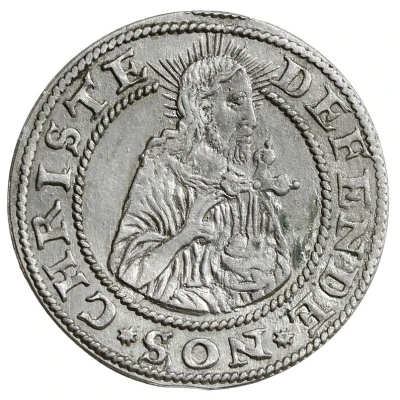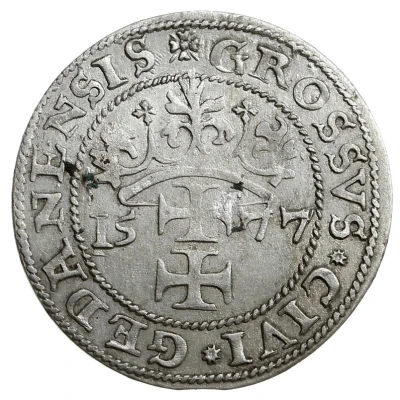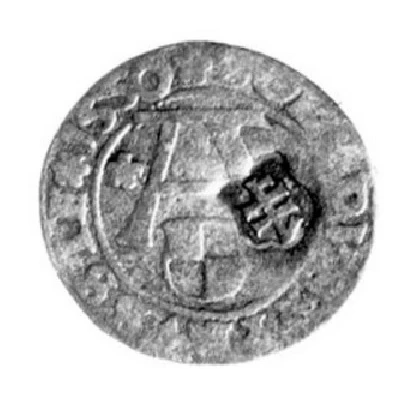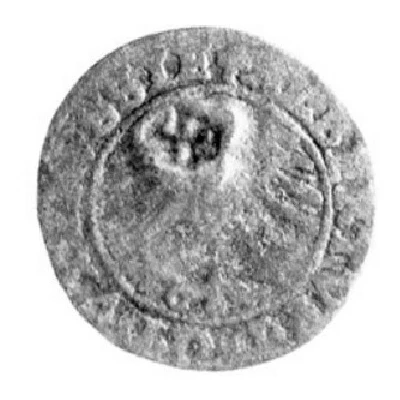


© Warszawskie Centrum Numizmatyczne s.j.
Groschen Siege coinage
1577 year| Silver | 1.8 g | 23 mm |
| Issuer | City of Danzig (Polish States) |
|---|---|
| King | Stephen Báthory (1576-1586) |
| Period | Danzig rebellion (1575-1577) |
| Type | Standard circulation coin |
| Year | 1577 |
| Value | 1 Groschen (1 Grosz) |
| Currency | First Złoty (1577) |
| Composition | Silver |
| Weight | 1.8 g |
| Diameter | 23 mm |
| Shape | Round |
| Demonetized | Yes |
| Updated | 2024-10-07 |
| Numista | N#96203 |
|---|---|
| Rarity index | 93% |
Reverse
Crowned arms of city of Gdańsk divides date
Script: Latin
Lettering:
✤ GROSSVS 🟌 CIVI 🟌 GEDANENSIS
15 77
Unabridged legend: Grossus civitatis Gedanensis
Translation: Grossus of the city of Gdańsk
Comment
When Stephen Batory was elected King of Poland in 1576, the city of Gdańsk refused to acknowledge his legitimacy, leading to the Gdańsk Rebellion which ended with Batory's siege of the city, ending in December 1577 with a negotiated peace.Kopicki 7388 / 7389 / 7391 / 7392 / 7393 / 7394
Personal observation by © geraltttt82
MAIN TYPE 1
Characteristics of main type number 1:
a.) crown with crosses
b.) little sun
c.) narrow crosses
Subtypes MT1
Punch 1:
ex.1
ex.2
Punch 2:
Punch 3:
Punch 4:
Punch 5:
Punch 6:
Punch 7:
Differences:
Punch 1:
Punch 2:
Punch 3:
Punch 4:
Punch 5:
Punch 6:
Punch 7:
Punch 1 ex.2 price: 2 700 PLN
--------------------------------------------------------------------------------------------------------------------------------------------------------------------------------------------------------
MAIN TYPE 2
Characteristics of main type number 2:
a.) crown without crosses
b.) no little suns but crosses or stars
c.) small crosses
Subtypes MT2
Punch 1:
Punch 2:
Punch 3:
Differences:
Punch 1:
Punch 2:
Punch 3:
--------------------------------------------------------------------------------------------------------------------------------------------------------------------------------------------------------
MAIN TYPE 3
Characteristics of main type number 3:
a.) crown without crosses with jackdaw above
b.) on reverse small dot, or nothing
c.) wide crosses
Subtypes MT3
Punch 1: Hybrid - crown with crosses
Punch 2: Hybrid - crown with crosses
Punch 3:
Differences:
Punch 1: Hybrid
Punch 2:
Punch 3:
--------------------------------------------------------------------------------------------------------------------------------------------------------------------------------------------------------
MAIN TYPE 4
Characteristics of main type number 4:
a.) crown without crosses (forked), with jackdaw above, in the half open circle
b.) on reverse clovers
c.) wide crosses
d.) different one in date
Subtypes MT4
Punch 1:
Punch 2:
Punch 3:
Punch 4:
Punch 5:
Punch 6:
Punch 7: Crown in closed circle, without jackdaw above, and without clovers on reverse
Punch 8: Crown in closed circle, without jackdaw above, without clovers, and without jackdaw on obverse
Differences:
Punch 1:
Punch 2:
Punch 3:
Punch 4:
Punch 5:
Punch 6:
Punch 7:
Punch 8:
--------------------------------------------------------------------------------------------------------------------------------------------------------------------------------------------------------
MAIN TYPE 5
Characteristics of main type number 5:
a.) crown without crosses (ornamental fragments), in the closed circle
b.) on reverse big dots
c.) wide crosses
d.) jackdaw to the right of Jesus and CHRISTE with overstruck T/E
Subtypes MT5
Punch 1:
Punch 2: Hybrid - not quite closed circle - and jackdaw above the crown
Differences:
Punch 1:
Punch 2: Hybrid
Interesting fact
The Groschen coin from the City of Danzig (now Gdańsk, Poland) was used as a siege coinage during the Swedish siege of the city in 1577. Siege coinage was a special type of currency issued during times of war or siege, when the regular supply of coins was disrupted. The Groschen coin was made of silver and weighed 1.8 grams, which was a relatively small weight for a coin at that time. Despite its small size, the coin was widely accepted and used as a means of exchange during the siege. Today, the Groschen coin is a rare and valuable collector's item, highly sought after by numismatists and historians interested in the history of Poland and the Baltic region.

